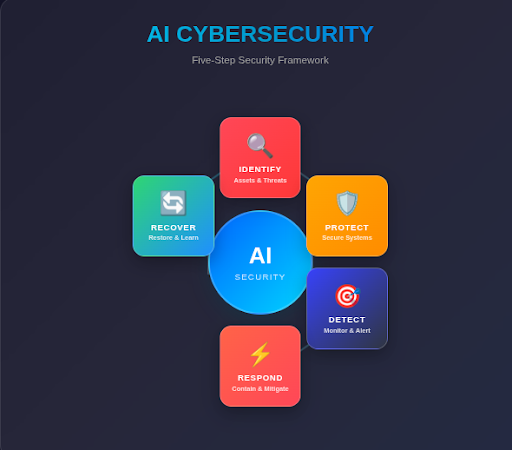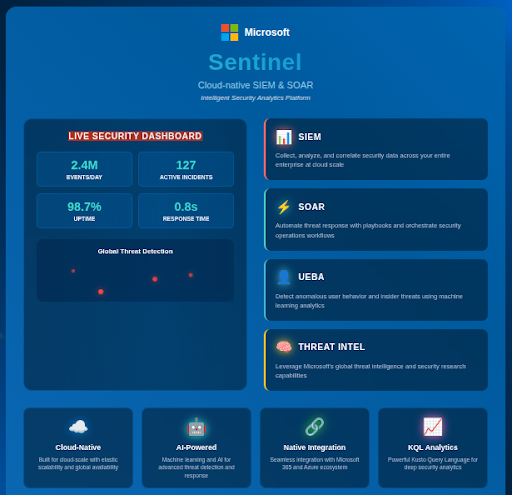“The coming era of AI will not be about man versus machine, but rather man with machine.” – Satya Nadella.
This thought perfectly articulates today’s cybersecurity landscape, reflecting AI’s indispensable role in delivering security-encrypted enterprise solutions in the modern age of digital transformation. Eager to equip themselves with such innovative solutions in this evolving landscape of cyber threats, companies are opting for the synergized integration of futuristic technological interventions and cybersecurity consulting.
In real time, this seamless integration does more than just defence. It also helps in early threat detection while ensuring cyber preparedness against potential attacks. Along with detection and prevention of threats, it also adds layered tech security measures to help companies fortify their business systems, bracing themselves from cyberattacks.
Considering these aspects, this article studies the essence of the partnership of AI technologies with comprehensive cybersecurity services. Moving forward, let’s explore AI’s essence, application, role, benefits, challenges, and its future potential in cybersecurity from the brands’ perspectives.
Understanding AI in Cybersecurity
AI in cybersecurity is a transformative force that leverages intelligent technologies to deliver security-embedded solutions to enterprises. Harnessing the latest technologies, AI in cybersecurity operates on five core functions of identification, detection, prevention, response, and recovery for effectively combating cyber threats.
- These functions mainly utilize data-driven insights from historical and real-time data, which assist cybersecurity professionals in identifying vulnerabilities & preventing cyber threats.
- Incorporating the latest AI tech stack also enables consultants to bolster the security measures in enterprise infrastructures.
Hence, the vast AI-powered capabilities offered by technologies like machine learning algorithms, deep learning, and NLP assist consulting service providers in shielding companies from sophisticated cyber threats, thereby safeguarding their virtual assets.
Reflecting this momentum, the cybersecurity market is projected to grow at 12.9%, attaining the benchmark of $500.70 billion by 2030. This reinstates that the crucial developments of AI in cybersecurity are leading it to become one of the most valuable business services in the future.
Role of AI in Cybersecurity
As the industry is shifting towards a hybrid blend of reactive and proactive measures, AI’s role in cybersecurity has been remarkably increasing among industries. It strategically acts as a pillar, defending digital systems from cyber threats, working on data-driven insights and predictive models of threat detection. To understand these aspects in detail, let’s uncover how AI contributes to enterprise cybersecurity.
-
Threat Detection and Prediction
Considered one of the prime defence strategies implemented by cybersecurity professionals, it analyzes the data points in real-time to assess vulnerabilities in the enterprise systems.
Understanding its operational aspects, these models study data patterns of previous cyberattacks, thereby gaining data-driven insights that help in predicting potential cyber threat situations.
-
Automating Security Operations Centres (SOCs)
This involves automating repetitive tasks like monitoring and scanning threats through leveraging the vast capabilities of AI.
Additionally, automation also contributes to building future-ready instant responses to cyber threat situations, without any human intervention. These may include blocking suspicious IPs or isolating potentially compromised data points, among others.
-
Risk Management
Working towards risk assessment and mitigation, AI helps continuously scan systems for vulnerability. Based on its real-time monitoring and analysis, it then provides dynamic risk scores for the anomalies detected that evolve with changing threat patterns.
-
Ensuring Data Compliance
This includes complying with the regulatory frameworks of HIPPA and GDPR. Cybersecurity professionals work on identifying gaps in compliance that can be filled in with the integration of AI technology algorithms. Additionally, it caters to strengthening application security through threat modelling, API security, and others.
Example:
One industry example built on cyber threat intelligence and automation is IBM QRadar SIEM. This modern tool is developed utilizing technologies like ML, NLP, and predictive analytics for streamlining compliance and reducing risk in cybersecurity management.
Application of AI in Cybersecurity
Artificial intelligence solutions leverage futuristic technologies in cybersecurity mechanisms to enhance the security systems of enterprises. The application of AI in cybersecurity in offering modernized business solutions follows a five-step process. These include: identification, protection, detection, response, and recovery.

Identification:
- This step works on an analytical study of the business environment and data sets.
- Additionally, it incorporates working on the risk assessment of the assets and enterprise infrastructure.
Protection:
- This step marches forward in the direction of creating an environment of cyber-preparedness in the enterprise.
- Considering the network and cloud security, it focuses on necessary security updates, multi-factor authentication, and other encryption measures.
Detection:
- The step assesses and intercepts unusual traffic and anomalies in the organization’s data patterns. Being intertwined with protection, it includes conducting vulnerability assessments and adding security patches to the enterprise’s software programs as needed.
- Here, vulnerabilities can be proactively monitored along with conducting behavioral analysis, focusing on strengthening the cybersecurity intelligence in the organization.
Response:
- This step lays out a detailed incident response plan and its communication strategy. These include working out the details of how the businesses will act if a cyber threat situation happens in real-time.
- This also adds the security of having a contingency plan in place for such a critical cyber situation.
Recovery:
- A strategic recovery plan is necessary to guide the business operations post-cyberattack.
- This includes conducting timely backup and recovery of the system data and applications that store important information. Moreover, focusing on system recovery is equally imperative by repairing and restoring the affected infrastructure.
Finally, these steps can be consistently done along with cybersecurity training to combat such severe threats gracefully, without losing important data and customer trust.
Emerging Technologies of AI in Cybersecurity Solutions
As the saying goes, Necessity is the mother of innovation; The nature of dynamically evolving cyberthreats has paved the way for technological innovations in cybersecurity measures. Thus, let’s briefly explore machine learning, deep learning, neural networks, expert systems, and NLP as part of AI in cybersecurity.
Technologies | AI Technologies’ Role in Cybersecurity |
| |
| Neural Networks |
|
| Deep Learning |
|
| Expert Systems |
|
|
Types of AI Automation in Cybersecurity
Realising the incredible prowess of AI technologies, we can understand the significance of adding the layered proactive approach of cybersecurity professionals and the real-time protection measures implemented by these innovators.
Moving forward, let’s delve into the types of AI automation. This section also covers the strategic impact of AI in cybersecurity services, as it ensures the security and automation of operational enterprise infrastructures.
-
Assisted AI Automation
Assisted AI automation is designed to add value to human capabilities, providing relevant data-driven insights and automation. It aims to improve the accuracy and efficiency of cybersecurity professionals through log analysis, anomaly detection, and scanning the cloud environment for vulnerabilities.
Example:
To understand the use of AI in cybersecurity, let’s look at an industry example. Microsoft Sentinel is a cloud-native solution that assists in the identification of suspicious login activity or in identifying unusual traffic patterns to detect potential cyber threat risks. It utilizes AI and machine learning in cybersecurity to provide threat intelligence and better response processes.

-
Augmented AI Automation
This AI technology opens up new portals of advancements by enabling real-time monitoring and application of predictive analysis for risk assessment in enterprise environments. Hence, this technology aims to achieve what is beyond human capabilities.
Example:
One of the exceptional examples of AI in cybersecurity is IBM QRadar technology. This technology enables real-time threat detection across the enterprise’s infrastructures and systems. Its advanced tech is built to correlate malware detection with highlighting priority risky assets and their critical security breach alerts.
-
Autonomous AI Automation
Autonomous AI technology operates without human intervention, which allows personnel to work on strategic tasks and their decision-making responsibilities.
Example:
Darktrace Antigena is an autonomous response AI platform in cybersecurity applications. This technology works on autonomous threat detection in real-time without human intervention.
-
Generative AI Development
This advanced technology is trusted by organizations to generate threat intelligence. Additionally, generative AI development is also capable of delivering advanced cybersecurity integrations like vulnerability management, phishing detection, and security automation.
Generative AI in cybersecurity can also enable the creation of a synthetic dataset for pre-training cybersecurity models and detecting deepfakes or AI-generated phishing threats.
Example:
Google’s developed DeepMind SynthID is a modern Gen AI tool that can identify AI-generated content, supporting fraud detection and ensuring authenticity across systems.
Benefits of AI in Cybersecurity
As the landscape of cyber threats evolves, from phishing attacks to malware to zero-day exploits, companies are eager to equip themselves with futuristic technological interventions and cybersecurity services to protect themselves against these threats. This is because the evolving technologies can definitely keep pace with the nature of cyber threats today.
Keeping this in mind, let’s understand the benefits of AI in cybersecurity solutions.
Benefits | Description |
| Enhanced Threat Detection |
|
| Improved Incident Response |
|
| Task-focused Automation |
|
| Leveraging Predictive Models |
|
| Adaptability and Learning |
|
AI vs Cybersecurity: Exploring the Imminent Risks of AI in the Cybersecurity Landscape
Embedding itself in modern cybersecurity frameworks, AI technology leverages multiple advantages while also posing some critical challenges. The paradox is that even cybercriminals utilize artificial intelligence technologies to target companies with sophisticated cyberattacks. In this context, a sophisticated cyberattack generally corrupts the enterprise data sets, including its existing and modern infrastructure. In this light, let’s walk through the challenges of AI in cybersecurity, followed by their ground-level solutions.
Challenges | Description | Solutions |
| Cybercrime Issues Powered by AI technologies | Attackers leverage AI and ML technologies to launch phishing, malware, and deepfake attacks |
|
| Data Poisoning | Attackers inject malicious data inputs into enterprise training models to impede performance |
|
| Privacy and Ethical Considerations | AI systems have access to confidential data, leading to a violation of compliance |
|
| Over-relying on Automation | Excessive utilization of AI without insights into decision-making |
|
Hence, AI technologies can empower digital transformative solutions in cybersecurity, while posing challenges through the emergence of AI technologies in modern-day cybercrime and unsupervised learning models. These can be prevented by utilizing the same future-ready technologies, but with the right service provider aiding the process.
Future of AI in Cybersecurity: How SparxIT can be your Cybersecurity Solution Partner?
Excited to harness these optimizing business benefits while navigating the risks through a roadmap, right?
Assisting with strongly established standards of performance, cybersecurity professionals at SparxIT can assure your enterprise better ROI and secure business systems with our future-ready AI-enabled solutions.
Looking forward to providing these solutions, we work on diverse enterprise-grade artificial intelligence use cases in cybersecurity for scalability and productivity. From phishing attacks to malware to zero-day exploits, our professionals are attuned to provide advanced cyber-resilient services. Moreover, we strategically integrate Gen AI for cybersecurity, with an emphasis on SOC software in an auto-detection and notification mode.
Conclusion
Thus, integrating AI technologies in cybersecurity services is the foundation for growth opportunities and secure business practices. AI’s vast capabilities balance various benefits like better incident response, automation, and more effective threat detection, with innovation and governance. Hence, it is the right step forward for building cyber resilience and fortifying your business systems.

Want to integrate AI in cybersecurity?
Frequently Asked Questions
How does AI enhance cybersecurity in enterprises?





AI in cybersecurity enables better productivity in enterprises. These include securing their systems with automated threat detection, predictive models for risk assessment, and enabling faster response mechanisms while minimizing human error.
What are the limitations of AI in cybersecurity?








Some of them include high data dependency and higher costs for leveraging the latest technologies. Other concerns may include the privacy of sensitive data that is shared with AI, and over-relying on automation to deliver results.
What are the latest advancements in AI for cybersecurity?








Among the recent advancements in AI for cybersecurity are modern technologies like Gen AI, which helps in threat analysis and intelligence. Additionally, automation is leveraged for advanced security processes, while AI also assists in developing effective threat response plans.



